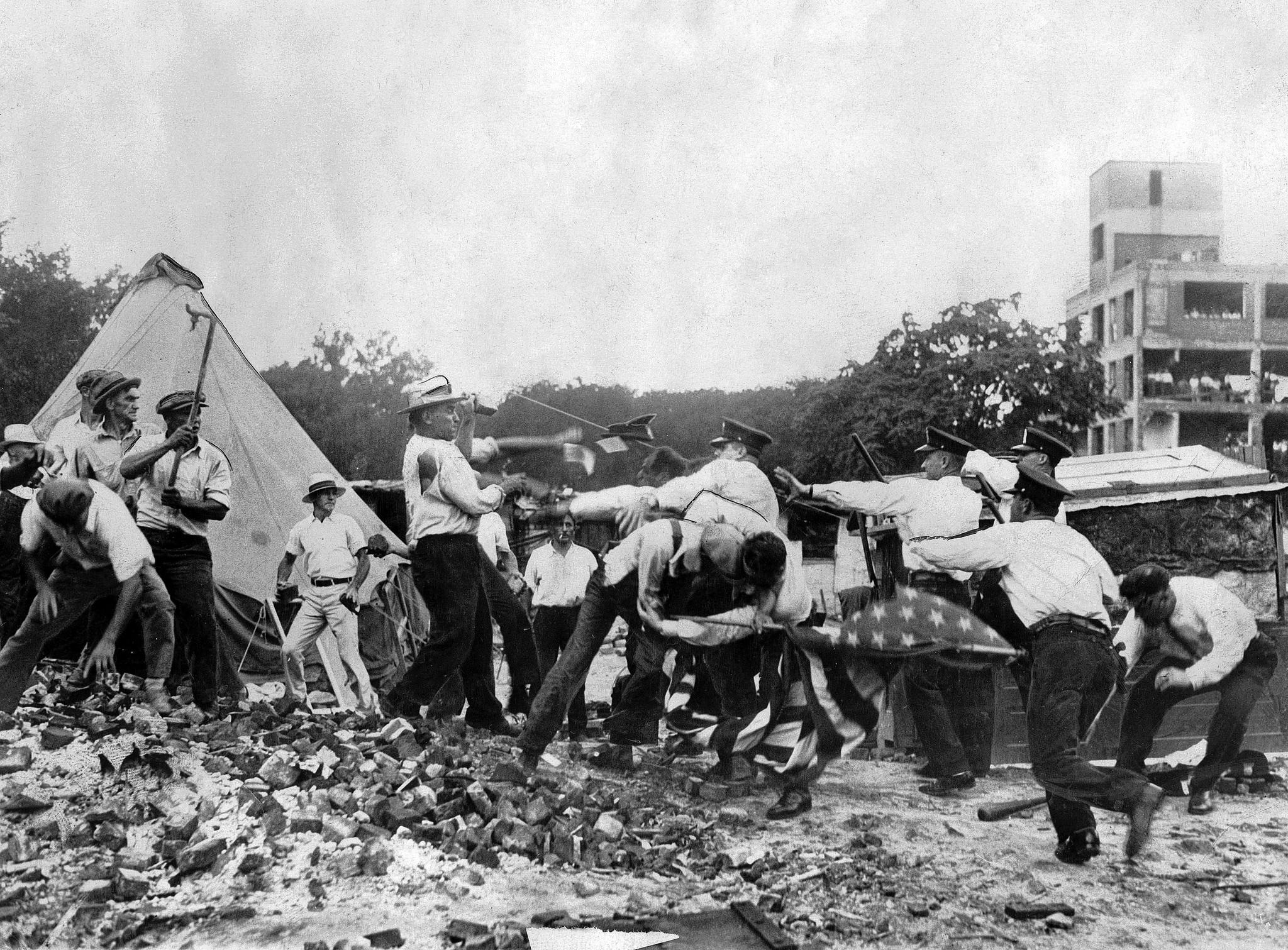
Bonus Army
The Bonus Army was a group of 43,000 demonstrators – 17,000 veterans of U.S. involvement in World War I, their families, and affiliated groups – who gathered in Washington, D.C., in mid-1932 to demand early cash redemption of their service bonus certificates. Organizers called the demonstrators the Bonus Expeditionary Force (B.E.F.), to echo the name of World War I's American Expeditionary Forces, while the media referred to them as the "Bonus Army" or "Bonus Marchers". The demonstrators were led by Walter W. Waters, a former sergeant.
Bonus Army
July 28, 1932
Impoverishment of World War I veterans due to the Great Depression
Demonstrators dispersed, demands rejected, Herbert Hoover loses 1932 presidential election
Many of the war veterans had been out of work since the beginning of the Great Depression. The World War Adjusted Compensation Act of 1924 had awarded them bonuses in the form of certificates they could not redeem until 1945. Each certificate, issued to a qualified veteran soldier, bore a face value equal to the soldier's promised payment with compound interest. The principal demand of the Bonus Army was the immediate cash payment of their certificates.
On July 28, 1932, U.S. Attorney General William D. Mitchell ordered the veterans removed from all government property. Washington police met with resistance, shot at the protestors, and two veterans were wounded and later died. President Herbert Hoover then ordered the U.S. Army to clear the marchers' campsite. Army Chief of Staff General Douglas MacArthur commanded a contingent of infantry and cavalry, supported by six tanks. The Bonus Army marchers with their wives and children were driven out, and their shelters and belongings burned.
A second, smaller Bonus March in 1933 at the start of the Roosevelt administration was defused in May with an offer of jobs with the Civilian Conservation Corps (CCC) at Fort Hunt, Virginia, which most of the group accepted. Those who chose not to work for the CCC by the May 22 deadline were given transportation home.[2] In 1936, Congress overrode President Roosevelt's veto and paid the veterans their bonus nine years early.
Aftermath[edit]
Joe Angelo, a decorated hero from the war who had saved Patton's life during the Meuse-Argonne offensive on September 26, 1918, approached him the day after to sway him. Patton, however, dismissed him quickly. This episode was said to represent the proverbial essence of the Bonus Army, each man the face of each side: Angelo the dejected loyal soldier; Patton the unmoved government official unconcerned with past loyalties.[42]
Though the Bonus Army incident did not derail the careers of the military officers involved, it proved politically disastrous for Hoover, and it is considered a contributing factor to his losing the 1932 election in a landslide to Franklin D. Roosevelt.[43]
Police Superintendent Glassford was not pleased with the decision to have the Army intervene, believing that the police could have handled the situation. He soon resigned as superintendent.
MGM released the movie Gabriel Over the White House in March 1933, the month Roosevelt was sworn in as president. Produced by William Randolph Hearst's Cosmopolitan Pictures, it depicted a fictitious President Hammond who, in the film's opening scenes, refuses to deploy the military against a march of the unemployed and instead creates an "Army of Construction" to work on public works projects until the economy recovers.[44] First Lady Eleanor Roosevelt judged the movie's treatment of veterans superior to Hoover's.[45]
During the presidential campaign of 1932, Roosevelt had opposed the veterans' bonus demands.[46] A second bonus march planned for the following year in May by the "National Liaison Committee of Washington," disavowed by the previous year's bonus army leadership, demanded that the Federal government provide marchers housing and food during their stay in the capital.[47] Despite his opposition to the marchers' demand for immediate payment of the bonus, Roosevelt greeted them quite differently than Hoover had done. The administration set up a special camp for the marchers at Fort Hunt, Virginia, providing forty field kitchens serving three meals a day, bus transportation to and from the capital, and entertainment in the form of military bands.[48]
Administration officials, led by presidential confidant Louis Howe, tried to negotiate an end to the protest. Roosevelt arranged for his wife, Eleanor, to visit the site unaccompanied. She lunched with the veterans and listened to them perform songs. She reminisced about her memories of seeing troops off to World War I and welcoming them home. The most that she could offer was a promise of positions in the newly created Civilian Conservation Corps.[45] One veteran commented, "Hoover sent the army, Roosevelt sent his wife."[49] In a press conference following her visit, the First Lady described her reception as courteous and praised the marchers, highlighting how comfortable she felt despite critics of the marchers who described them as communists and criminals.[45]
On May 11, 1933,[50] Roosevelt issued an executive order allowing the enrollment of 25,000 veterans in the CCC, exempting them from the normal requirement that applicants be unmarried and under the age of 25.[51] Congress, with Democrats holding majorities in both houses, passed the Adjusted Compensation Payment Act in 1936, authorizing the immediate payment of the $2 billion in World War I bonuses, and then overrode Roosevelt's veto of the measure.[52] The House vote was 324 to 61,[53] and the Senate vote was 76 to 19.[54]
In literature[edit]
The shootings are depicted in Barbara Kingsolver's novel The Lacuna.[55]
The Bonus Marchers are detailed in John Ross's novel Unintended Consequences (novel).
A fictionalized version of the Bonus March is depicted in the opening scenes of the 1995 movie In Pursuit of Honor.